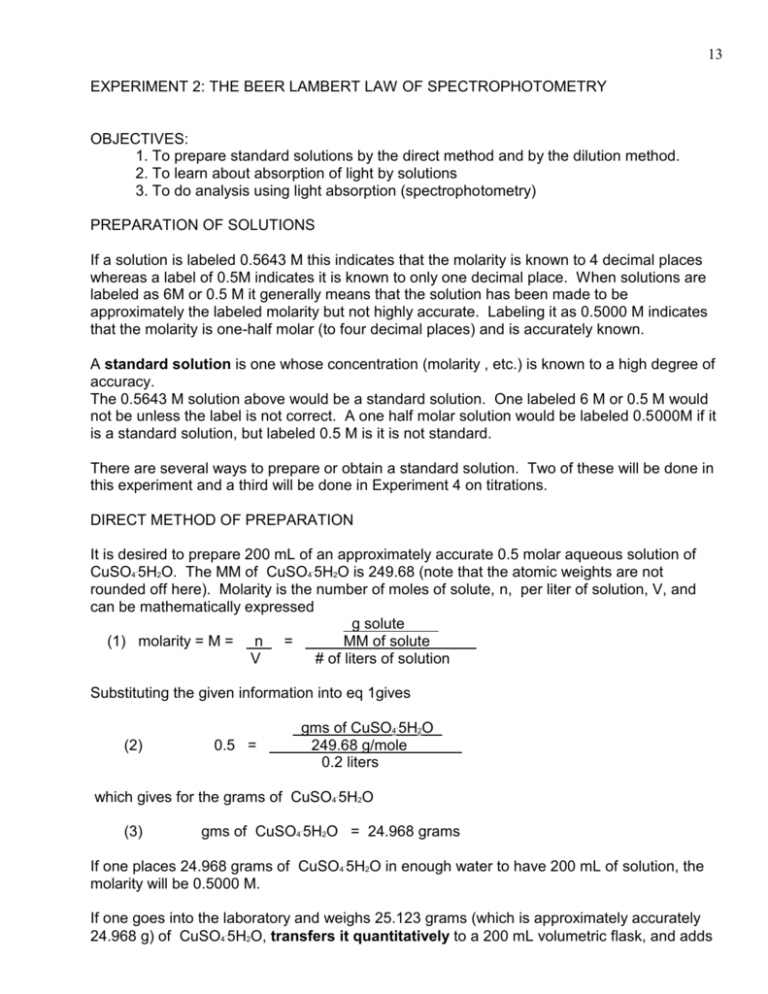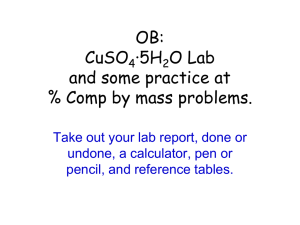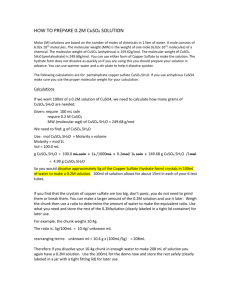Background material for 124 experiment 2
advertisement

13 EXPERIMENT 2: THE BEER LAMBERT LAW OF SPECTROPHOTOMETRY OBJECTIVES: 1. To prepare standard solutions by the direct method and by the dilution method. 2. To learn about absorption of light by solutions 3. To do analysis using light absorption (spectrophotometry) PREPARATION OF SOLUTIONS If a solution is labeled 0.5643 M this indicates that the molarity is known to 4 decimal places whereas a label of 0.5M indicates it is known to only one decimal place. When solutions are labeled as 6M or 0.5 M it generally means that the solution has been made to be approximately the labeled molarity but not highly accurate. Labeling it as 0.5000 M indicates that the molarity is one-half molar (to four decimal places) and is accurately known. A standard solution is one whose concentration (molarity , etc.) is known to a high degree of accuracy. The 0.5643 M solution above would be a standard solution. One labeled 6 M or 0.5 M would not be unless the label is not correct. A one half molar solution would be labeled 0.5000M if it is a standard solution, but labeled 0.5 M is it is not standard. There are several ways to prepare or obtain a standard solution. Two of these will be done in this experiment and a third will be done in Experiment 4 on titrations. DIRECT METHOD OF PREPARATION It is desired to prepare 200 mL of an approximately accurate 0.5 molar aqueous solution of CuSO4.5H2O. The MM of CuSO4.5H2O is 249.68 (note that the atomic weights are not rounded off here). Molarity is the number of moles of solute, n, per liter of solution, V, and can be mathematically expressed g solute (1) molarity = M = n = MM of solute V # of liters of solution Substituting the given information into eq 1gives (2) 0.5 = gms of CuSO4.5H2O 249.68 g/mole 0.2 liters which gives for the grams of CuSO4.5H2O (3) gms of CuSO4.5H2O = 24.968 grams If one places 24.968 grams of CuSO4.5H2O in enough water to have 200 mL of solution, the molarity will be 0.5000 M. If one goes into the laboratory and weighs 25.123 grams (which is approximately accurately 24.968 g) of CuSO4.5H2O, transfers it quantitatively to a 200 mL volumetric flask, and adds 14 water to the mark while dissolving the copper sulfate, then the molarity is (4) M = 25.123 g 249.68 g/mole 0.200 liters = 0.5031 moles per liter TO TRANSFER QUANTITATIVELY HERE MEANS TO TRANSFER THE SOLID FROM THE WEIGH BOAT TO THE FLASK WITHOUT ANY LOSS OF SOLID. IN GENERAL IT MEANS TO TRANSFER WITHOUT LOSS OF MATERIAL. The above illustrates how one chooses the amount of solution (the 200 mL) that is desired and then calculates how much solute is required (the 24.968 grams of CuSO4.5H2O). When the actual weighings are done in the laboratory, slightly different weights may be obtained (the 25.123 gms) and the molarity of the actual solution obtained can be calculated (eq 4). Exactly 24.98 grams can be weighed with some effort if it is important that the molarity be the exact value of 0.5000M. However, this is usually not the case and weighing an approximately accurately amount is generally easier. DILUTION OF SOLUTIONS TO OBTAIN A STANDARD SOLUTION Suppose one wishes to prepare 50 mL of a solution of CuSO 4.5H2O that is approximately accurately 0.2M. This can be done by accurately diluting the 0.5031M solution above. 1 can be rearranged to give (5) n = MV By eq 5, the number of moles of CuSO4.5H2O in 50 mL of a 0.2 M solution is (6) n = (0.2 moles/liter)(0.050 liter) = 0.01 moles The volume of the 0.5031M solution, V, that contains 0.01 moles of CuSO 4.5H2O must be related by eq 5 (7) 0.01 moles = (0.5031 moles/liter)(V liters) (8) V = 0.01987 liters = 19.87 mL If 19.87 mL of the 0.5031M solution is diluted with water until the total volume is 50 mL, the molarity of the solution would be 0.2000. If one takes 20.00 mL of the 0.5031M soluton and dilutes it to 50 mL, the molarity of the solution can be calculated from (9) (0.5031)(0.020) = M(0.050) (10) M = 0.2012 mole per liter of CuSO4.5H2O It is possible to measure out the volume of 19.87 mL using a burette and obtain an exactly 0.2000 M solution. It is often more convenient to measure the volume of 20 mL accurately Eq 15 with a pipette and calculate the molarity. This will be done in this experiment in order to get experience using pipettes. Eq 9 equates the number of moles of CuSO4.5H2O in 20 mL of the 0.5031M solution (the left side of eq 9) to the number of moles of CuSO4.5H2O in the 50 mL obtained by diluting the 20 mL with water. The number of moles of CuSO4.5H2O must be equal because the only CuSO4.5H2O in the final 50 mL came from the original 20 mL. A more general form of eq 9 is (11) M1V1 = M2V2 which can be used in dilution situations. By eq 6, the number of moles of solute in 50 mL of a 0.2M solution is (12) n = (0.2moles/liter)(0.050 liter) = 0.01 moles = 10 millimoles A millimole is 1/1000 of a mole. Therefore 0.01 mole is 10 millimoles in the same way that 0.01 liters is 10 milliliters. Note that if the volume is expressed in milliliters the product of molarity and volume as in eq 12 becomes (13) n = (0.2 millimoles/mL)(50 mL) = 10 millimoles where in eq 13 the molarity is written with units of millimoles/mL. A millimole per milliliter is the same numerically as a mole/liter. THE PRODUCT MV GIVES THE NUMBER OF MOLES OF SOLUTE IF THE VOLUME IS IN LITERS OR THE NUMBER OF MILLIMOLES IF THE VOLUME IS IN MILLILITERS. M1V1 = M2V2 amounts to equating the initial and final number of moles or equating the initial and final number of millimoles depending on the units of volume used. In the equation MiVi = MfVf, the units used for volume in doing calculations do not matter as long as Vi and Vf are both used in the same units. Both the direct method and dilution method of preparing solutions can be used to prepare a solution to be approximately a given molarity. Then a titration method is used to determine the accurate value of the concentration. See Experiment 4 for this method of preparing solutions. 16 ABSORPTION OF LIGHT BY SOLUTIONS If light is passed through a sample of material (a solid, liquid or gas and either pure or a mixture), some of the light is absorbed by the material. Figure 1 is a diagram of a simple spectrometer, an instrument to measure the absorption (or emission also) of light. The instrument used in this experiment will measure the transmittance of solutions (see below for definition). If the intensity of light entering the sample is I0 and the intensity of the light exiting the sample is I, then the transmittance, T, is defined as (14) T= I I0 and is the fraction of the light that is transmitted through the sample. The values of T range from 0 to 1. The quantity 100T is called the percent transmittance (%T) and ranges from 0 to 100. The transmittance of a sample is found to depend on the following: 1. the nature of the substance absorbing the light 2. the wavelength (color) of the light A good way to think of wavelength is to associate it with color. Different colors of light have different wavelengths. The wavelength increases in going from blue light to green to yellow to red. Light that the human eye cannot see has wavelengths longer than red and also shorter than blue but thinking about it in terms of color is a good beginning. 17 The light from the sun and from electric lights is called Awhite light@ and contains all the colors of light. When a substance absorbs the red parts of the light, it will appear to be blue (or green depending on which parts of the red it absorbed and how our eyes perceive this). If the percent transmittance at different wavelengths is determined (at fixed concentration and path length), a graph such as Figure 2 is obtained for copper (II) ions in water solution. The shape of the transmittance versus wavelength curve (that is, where it absorbs light and how much it absorbs) is characteristic of copper (II). Other materials will exhibit a different graph of transmittance versus wavelength. It is sometimes said that the graph represents a Afingerprint@ of the copper (II) species. It should be noted that the graph in Figure 2 gives information about how ε changes with wavelength for a given substance since at fixed path length and concentration, ε and A ( = -log T) are directly proportional to one another (see eqs 14 and 15 below). 3. the path length, b, of the light through the solution (Figure 1) As the path length b increases, the amount of light absorbed increases as found by Lambert. This seems to be true at all wavelengths and all concentrations for all species. 4. the concentration of absorbing material in a solution. In this experiment, factors 1, 2 and 3 above remain fixed (are constant) during the course of the experiment and the concentration changes. The concentration of a gas in a volume is dependent on the pressure and the temperature so these must be taken into account when the transmittance of a gas sample is measured. The absorbance, A, is defined as (15) A = - log T 18 and the values of A will then range from 0 to infinity. In general, instruments (spectrometers or spectrophotometers) are used to measure T although older methods (using Nessler tubes) used the human eye to do relative measures of T. The quantities I and I0 are generally not measured separately, just their ratio, which is T. The absorbance depends on the same things the transmittance does. In 1760, J.H. Lambert discovered that the absorbance of a solution (at constant concentration and fixed wavelength) is proportional to the path length of the light through the solution (b in Figure 1 and eq 16). In 1852, A. Beer discovered that (for a fixed path length and wavelength), the absorbance of a solution is proportional to the concentration of the solution. Beer=s relationship holds only for low concentrations (how low depends on the compound that is absorbing light). As the concentration of any solute increases, a concentration is reached above which Beer=s relationship is not valid. Lambert=s law is true in almost all situations. These two relationships can be combined into one equation as shown in eq 16 and is called the Beer-Lambert law. (16) A = εbC = KC if the path length and ε are constant The quantity ε in eq 16 is the proportionality constant and is called the absorptivity. If the concentration is in moles/liter, it is called the molar absorptivity. The dependence of A on the path length and concentration are obvious in eq 16. The absorptivity ε contains the dependence on the nature of the absorbing material and on the wavelength of the light used. The absorbance and transmittance of a solution are extensive variables since their values depend on the path length which depends on the amount of solution one has. The absorbance and transmittance at fixed path length are intensive variables. The absorptivity is an intensive variable, it does not depend on the amount of material one has. If the transmittance of several standard solutions (known concentration) are measured, then the absorbance can be calculated and a graph of A versus C can be prepared. For a solution of unknown concentration, one measures its transmittance (at the same wavelength and path length as the standards) and calculates its absorbance from the transmittance. Using the absorbance and the graph, the concentration of the solution can be be determined. If 10 mL, 25 mL and 35 mL of the 0.5031M solution discussed above are separately each diluted to 50 mL, the concentrations of the solutions obtained are shown in Table 1. The % transmittance values in the second column are measured with a spectrophotometer (a Spectronic 20 or 21 in this experiment). The other values in Table 1 are calculated and a graph of absorbance (= - log T) is made. This is shown in Figure 3. The unknown has a transmittance of 0.33 which is equivalent to an absorbance of 0.48. A horizontal arrow is shown at A = 0.48 in Figure 3. Where it crosses the line of the graph, a vertical arrow is drawn which crosses the concentration axis at a concentration of 0.32 M. The concentration of the unknown is therefore 0.33 M. Table 1. Transmittance versus Molarity for Copper (II) Sulfate Solutions 19 Molarity % Transmittance Transmittance, T Absorbance (= - log T) 0.5031 19.3 0.193 0.714 0.3522 32.0 0.320 0.495 0.2516 45.3 0.453 0.344 0.1006 72.5 0.725 0.140 Unknown 33.1 0.331 0.480 Figure 3. Absorbance versus Molarity for Copper(II) Sulfate in Water ADDITIVITY OF VOLUMES OF COMPONENTS IN A SOLUTION A sample of CuSO4.5H2O is placed in a volumetric flask and water added to the mark on the flask (see procedure I-1 below). At this point the total volume is equal to the volume of the water plus the volume of the solid CuSO4.5H2O because very little of the solute has dissolved. If the flask is shaken and the CuSO4.5H2O dissolves in the water, the volume of the solution is less (the level of liquid is below the mark) than the sum of the volumes of the two components separately. This illustrates the principle that when two substances are dissolved in one another the sum of the volumes separately is not equal to the volume of the solution. The solution volume can be less (as in the CuSO4 -water solution above) or it can more in some cases. That is why when solutions are diluted, a volume of the solution to be diluted is measured accurately and placed in a volumetric flask; then water is added until the total volume is that of the flask. If 10 mL of solution is added to 90 mL of water the volume may not 20 be exactly 100 mL. Since the total volume must be used in equations such as (10), this procedure will not in general give good results. HYDRATES The compound CuSO4.5H2O is an example of a hydrate. The 5 water molecules indicated in the formula are not just water that is sticking to the surface of the solid copper sulfate. Some of them are chemically bonded to the Cu(II) ion and all are an integral part of the structure of CuSO4.5H2O. The solid CuSO4.5H2O will not appear wet. Many metal compounds form hydrates such as this. USE OF A WATER ABLANK@ OR REFERENCE When making transmittance measurements on the copper(II) sulfate solutions, it is desired to measure the absorbance due to the copper(II) sulfate alone and not the water. To do this, a test tube of pure water is placed in the instrument (see Figure 1) and the electronics of the Spectronic are adjusted so that the instrument reads 100% transmittance. If this test tube is replaced with a copper(II) sulfate solution, the water in the solution will absorb the same amount of light that the pure water did and any difference in transmittance is due to the copper(II) sulfate in the solution. It is said that a water blank is used.









